What is the Best Paper for Fountain Pens?

What is the Best Paper for Fountain Pens?
I used to think that I hated fountain pens.
When I came across my first one as a wee lass, I thought it was the coolest pen I had ever seen aside from my footlong pink flamingo pen complete with feathers coming out of the top.
Then I wrote with said fountain pen…
My letters fused together into one amorphous blob, I smeared constantly, and when I did flip over the page to write on the back I couldn’t because all the letters had bled through to the other side.
Years later, I started working for a pen company and, once again, became enamored with fountain pens. But this time, I learned what was truly at fault for my disastrous early encounter…it was the PAPER.
Hence, this article.
I will explain which fountain pen paper brands are the best, why fountain pens need special paper, and give you some tips to enjoy writing with your fountain pen.
Now onto the main question of the day, what is the best paper for fountain pens?
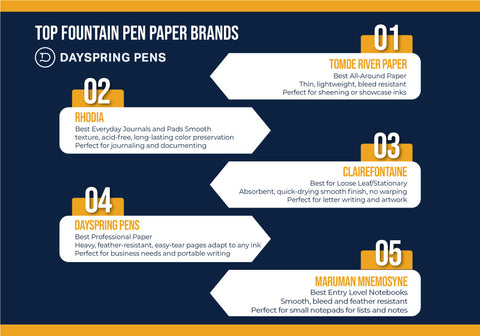
What are the Top Brands of Fountain Pen Friendly Papers?
There are numerous brands offering fountain pen friendly papers, and choosing the high quality paper that matches your needs and budget can be challenging.
In this section, I’ll go through some of the best brands of paper for fountain pens to help make your selection process easier.
Tomoe River Paper
A favorite among fountain pen users, Tomoe River Paper (called TRP for short) is the best fountain pen-friendly paper brand.
It is thin and lightweight paper. Notebooks made of TRP have a low profile, even with hundreds of pages. This makes TRP notebooks incredibly lighter than other notebooks with similar page counts.
Despite its weight, TRP is highly resistant to bleeding. Thanks to a special smooth coating on both sides of the paper, ink sits on the surface instead of being quickly absorbed into the page.
This means TRP has a slow drying time, but that’s a small price to pay for the beautiful results once the ink dries.
Tomoe River Paper is especially great for shading inks because it brings out the subtle color gradations as you lay down the ink on paper.
Sheening inks also take well to TRP, since pools of color will sit on the surface of the paper, creating the reflective effect favored by many fountain pen users when the ink dries.
As long as you remember to let the ink fully dry on the page, you won’t experience any smudging.
Old Vs New Tomoe River Paper
There are two kinds of Tomoe River Paper: the ‘old’ and the ‘new’ Sanzen paper. Here’s a bit of background about how this came to be.
In late 2020, Tomoegawa, the company that makes TRP, announced that it was about to cease production of Tomoe River Paper by shutting down machine #7. ‘New’ TRP would be made through machine #9 until the end of October 2021, after which there would be no more paper.
This brought uncertainty in the fountain pen world. Sanzen Paper company soon took over by buying the rights to Tomoe River, and continues to produce the new TRP to this day.
You might be wondering whether there are any differences between the two Tomoe River Paper versions apart from being made by different companies. Yes, the old and new varieties are significantly different.
Let’s look at how they vary:
- New TRP dries faster than the old, meaning reduced smudging.
- New TRP runs slightly thicker than the old when stacked up.
- Some inks show up slightly differently in color on the old vs the new.
- Old TRP has crispier edges compared to the new.
- The increased thickness of the new TRP results in less ghosting.
- New TRP has more ‘tooth’ (texture) than the old.
- Some users have reported their fountain pen inks with a vivid amount of sheen appearing ‘flat’ on the new TRP.
- Old TRP is more crinkly than the new.
Whether you choose the old or new TRP, it still gives superior results compared to non-fountain pen-friendly paper.
If you’ve tried both versions of TRP, I’d love to hear about your experiences in the comments.
Rhodia
Rhodia is actually my go-to daily writing paper.
Rhodia paper is smooth in texture, making it ideal for fountain pens since the nib won’t snag on the fibers.
Despite being smooth, it balances drying time with being bleed-through and show-through resistant. Rhodia paper handles ink well no matter the nib/ink combination you use.
Being acid free and pH neutral, this paper remains stable for years when exposed to light or heat. This means your fountain pen colors retain their true hues without fading quickly.
Highlight: Rhodia and its parent company Clairefontaine are sustainably produced. They have a certification from the Programme for the Endorsement of Forest Certification (PEFC), a non-governmental organization which promotes sustainable forest management.
Rhodia provides different sheet styles to suit various uses: blank, lined, graph, and dot grid. If you find the page ruling of your paper is a brown or dark gray color instead of the typical pale violet color, don’t be alarmed. The color of the ruling varies depending on the product line.
If you need fountain pen-friendly paper readily accessible without having to lug around a notebook, then you’ll love Rhodia’s notepads. They allow you to remove individual sheets easily without damaging the pads.
These notepads come in several styles:
Rhodia notepads vary in weight, cover color, and ruling color to accommodate different preferences.
Clairefontaine
Clairefontaine’s top selling point is its ability to handle liquid ink exceptionally well. This more absorbent paper holds up to wet pens and inks without warping, feathering, or bleeding through. Also, fountain pen ink color appears vibrant and true to color on Clairefontaine paper.
The smooth, satin surface finish of this paper reduces friction on the nib and provides a controlled ink flow, offering a comfortable writing experience.
Despite being smooth on the surface, Clairefontaine allows ink to dry relatively quickly compared to other smooth papers such as Tomoe River. This means you’re far less likely to smudge or accidentally transfer ink when you close your notebook or turn the page.
If you are doing some sketching or drawing, this fountain pen paper is excellent.
The acid-free and archival quality of this paper is great for preserving your notes and sketches in true color for years, as the paper doesn't fade quickly when exposed to light.
Clairefontaine paper is available in a variety of formats such as notebooks, notepads, loose leaf papers, and journals. This makes it easy for you to find the perfect paper format for your needs whether it is good paper for journaling or letter writing paper.
If you’re just getting started with fountain pen writing, you might be concerned about the cost of using Clairefontaine since this hobby isn’t necessarily cheap.
Clairefontaine is one of the more reasonably priced fountain pen-friendly paper available on the market, allowing you to get the hang of using fountain pens without worrying about emptying your wallet.
Dayspring Pens
The 40-page notepad that comes with the Dayspring Pens Leather Padfolio is great for fountain pens. It features heavy 100 GSM dot paper that handles liquid ink incredibly well with no feathering, bleed-through, or ghosting.
This is actually one of my favorite papers.
Its perforations enable easy tearing and make the notepad suitable for any writing modality, be it to-do lists, notes, or reminders.
If you use fountain pens on work documents, the Dayspring Pens padfolio is a great choice. It’s perfect for organizing your documents in one place, keeping them secured with two brass snaps.
There’s also enough space for a tablet and a cutout to hold your fountain pen to keep it from getting misplaced.
What’s more, you can personalize the padfolio with your name or a special quote and make it truly unique to your taste.
Midori
When shopping for Midori paper, you’ll come across two types:
- Midori Cotton
- Midori MD
Midori Cotton causes a lot of feathering with wet nibs, so it’s best to skip this variety.
On the other hand, Midori MD is highly rated among fountain pen enthusiasts for several reasons relating to how it handles fountain pen ink excellently.
With Midori MD, there’s no bleeding or feathering, which allows you to use a variety of nibs and write on both sides of the page. Ghosting/show-through is average, nothing crazy that could ruin your writing experience.
When it comes to sheening, Midori MD sheens well though not as much as Tomoe River Paper.
Smudging isn’t an issue with this paper due to its decent dry time and left-handed people will find it particularly helpful.
Midori MD also doesn’t absorb much oil from your hand as you move it across the page, meaning that both the paper and the inks retain the appearance of their colors.
If you prefer a little feedback while writing, Midori MD is right up your alley. It provides the perfect balance between smoothness and a little resistance, giving it a tactile writing experience.
The cream color of the paper does affect the appearance of inks a little. If this is something you’re sensitive about, Midori MD might not be the choice for you.
Midori MD is available in notebook, journal, and diary formats with different ruling styles. So whatever you want to use this paper for, you’ll find something that matches your needs.
Below is a table comparing the features of the top 5 fountain pen-friendly papers:
| Paper Brand | Tomoe River Paper | Rhodia | Clairefontaine | Midori | Dayspring Pens |
| Paper Weight (GSM) | 52, 68 | 80-90 | 90-120 | 80 | 100 |
| Texture | Ultra-smooth | Smooth | Smooth | Soft | Smooth |
| Bleed-resistance | Good | Excellent | Excellent | Good | Good |
| Feathering-resistance | Excellent | Excellent | Excellent | Good | Excellent |
| Absorption Rate | Slow | Minimal | Minimal | Moderate | Minimal |
| Opacity | Low | High | High | Moderate | Moderate |
| Page Styles | Lined, Dot Grid, Blank | Lined, Dot Grid, Graph, Blank | Lined, Dot Grid, Blank | Lined, Blank | Dot |
Maruman Mnemosyne
Maruman Mnemosyne paper is beautifully smooth, making writing on it with fountain pens easy and enjoyable.
It’s also bleeding and feathering resistant, though you might experience a bit of show-through especially with wet nibs.
The paper has good dry time and its gentle off-white color is easy on the eyes. It’s available in different notebook formats from three product lines:
- Basic Style - For everyday regular note taking
- Creative Style - Landscape format notebooks best suited for designers and other creative professionals who do lots of sketching
- Speedy Style - Ideal for quick notes at your desk or on the go
Maruman Mnemosyne is a fantastic option for those looking for affordable pen-friendly papers.
Leuchtturm1917
Among fountain pen users, Leuchtturm1917 is well loved as an affordable alternative to premium fountain pen-friendly papers.
Leuchtturm1917 notebooks have impressive build and paper quality, considering that they’re significantly less expensive than similar notebooks. They also feature other cool details such as:
- Numbered pages
- A table of contents
- Back pockets
- Stickers for labeling the binding
The Notebook Classic in particular is designed to be fountain pen-friendly.
Its 80 GSM paper is archival-safe and acid-free, keeping fountain pen ink looking great for years. It’s also smooth, but not super smooth like Rhodia, and lacks a coating that would slow down ink absorption.
Why It Matters: Coatings that slow down ink absorptions are critical when using wetter inks as they prevent feathering and bleedthrough. It means slower try times, but less problems with a wetter ink or a fountain pen that releases more ink when writing (like broad tips or italics).
These qualities plus its good bleed-through resistance make the Notebook Classic a popular choice among fountain pen enthusiasts.
Do fountain pens need special paper?
At the end of the day, fountain pens will work on any regular paper that is not glossy, so you technically do not need special paper to use a fountain pen.
Will using special paper drastically change your experience using a fountain pen?
Yes.
For you to get the best experience while using fountain pens, it’s important to use top-notch paper specially designed for fountain pens.
It’s like pairing comfy shocks with your shoes. Necessary? Maybe not. Incredibly impactful to your day? Definitely.
Carefully selecting the paper you use with your fountain pen gives you a pleasant writing experience that ordinary paper won’t.
Problems you will experience when using paper that’s not suitable for fountain pens include:
Feathering
This occurs when ink gets absorbed by the fibers of the paper and spreads outwards like a feather from where it’s laid down, resulting in uneven, ragged edges.
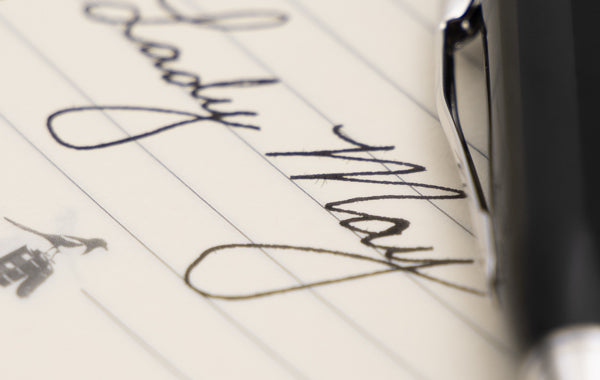
Ghosting/Show-through
Ghosting refers to when a shadow is visible on the other side of the page of what you’ve written. The level of show-through depends on the thickness of the paper, with thicker paper giving less show-through.
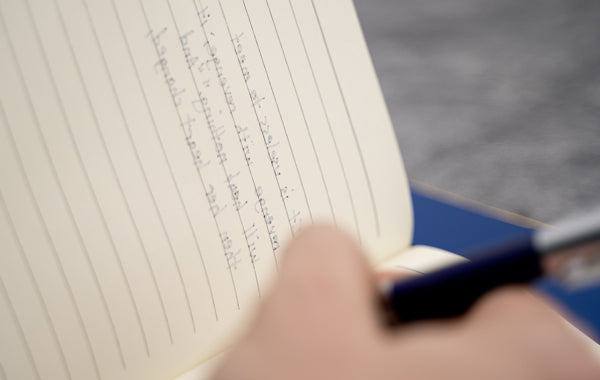
Bleed-through
When a paper is too thin or highly absorbent, ink seeps through the paper to the other side of the page, sometimes all the way through to another page.

Dry Time
Papers with less absorbency allow the ink to sit on the surface for long before it dries, meaning they have a slow dry time. While such paper resists bleeding and feathering, the ink is highly prone to smudging.

Do fountain pens work on notebook paper?
Technically, yes.
Notebook paper gets the job done, but with mediocre results. Like wearing sandals in a snowstorm, it’s uncomfortable and likely to leave you with the mess I mentioned in my epic saga above.
For all the issues that can arise using notebook paper, see the above both in story and in technical details.
What makes fountain pen friendly paper?
Fountain pen-friendly paper is specially designed to eliminate the problems we looked at earlier like feathering and ghosting.
Let’s take a look at paper characteristics that affect the quality of writing when using fountain pens.
- Paper weight - Measured in grams per square meter (GSM), this determines the thickness and sturdiness of the paper. Heavier paper (80GSM and above) is resistant to ink bleed-through and feathering (more on that in the next section).
- Texture/smoothness - For fountain pens, a paper with smooth or satin finish works best since it minimizes friction between the paper and the nib. It also enables smooth writing because it enhances ink flow.
- Opacity - This refers to how much light passes through the paper. High opacity paper prevents ink from showing through from the other side of the page.
- Color/shade - White and soft off-white paper allows fountain pen inks to show their true colors.
- Absorbency - Highly absorbent paper enables fountain pen ink to dry quickly. However, such paper tends to cause feathering as the ink seeps into the paper fibers and spreads out. Fountain pen-friendly paper balances absorption rate with dry time.
- Acid-Free - Normal paper is made of unrefined wood pulp which is naturally acidic and causes the paper to turn yellow and become brittle. Acid-free paper (also known as archival paper) can last more than 1,000 years while retaining its structure and color, and maintaining the true hues of fountain pen inks.
- Binding and Layout - Fountain pen paper comes in various forms like notebooks, loose sheets, and notepads. The layouts also vary from blank, line to grid, graph, and dot lined. These formats allow you to match the paper to appropriate applications, such as a blank sheet for sketching or dot lined paper for artistic lettering.
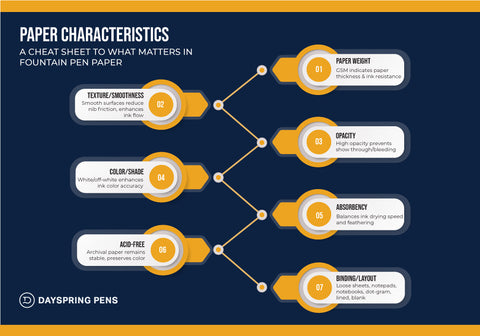
What is the best paper thickness for a fountain pen?
Paper thickness refers to the measure of the weight and sturdiness of paper. In general, thicker paper gives good results when using fountain pens because it handles liquid ink without causing bleeding or feathering.
What is the best paper weight for fountain pens?
Paper weight is synonymous with thickness, and it’s measured in GSM (grams per square meter).
Medium to high GSM paper starting from 60 GSM up to 90 GSM guarantees you excellent results when using fountain pens since it is thick enough to resist bleeding and feathering.
Fine nibs produce less ink since they have incredibly thin writing lines and so work great with lower GSM paper, while broad nibs need higher GSM paper because they lay down more ink.
Tips for Choosing the Right Paper for Fountain Pen Users
If you are having trouble with any of the major pitfalls of low-quality paper, here is a breakdown of how to avoid these problems.
How To Stop Feathering
To reduce feathering, you can use nibs with finer points or dryer flow. Such nibs produce less ink so you’ll have fewer chances of it spreading through the paper.
Writing with dryer inks like Pelikan 4001, R&K Salix Scabiosa or feather-resisting inks like Waterman Mysterious Blue, or Noodler's X-Feather will also help.
How To Stop Bleedthrough
Use a thick paper which doesn’t allow ink to soak through. This means a paper with higher GSM.
If you do not want to use a thicker paper, try spraying your paper with a permanent matte fixative. The fixative creates a non-absorbent layer on the paper’s surface, ensuring the ink stays in place when you write. This will impact dry-time though so be aware.
How To Avoid Dry Time
The key to dry-time is absorbency. The faster the paper absorbs the less smudging.
In my opinion the best papers balance dry times and bleedthrough. If you’re left-handed, paper with fast dry time will prevent smudging as your hand moves across the page.
Great options for fast-drying paper include Kokuyo KB Paper, ClaireFontaine My Essential journals, and Maruman Mnemosyne paper.
Tip for Lefties: When you need fast dry times, the type of ink you use is critical. Look for fast-drying inks like Noodler’s Brevity and Polar lines or Pilot’s Iroshizuku.
Paper Format
Fountain pen-friendly paper comes in different formats such as dot grid, ruled, or blank.
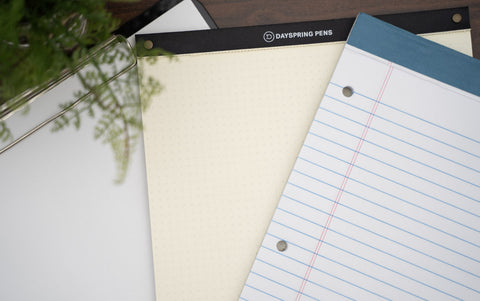
If you do lots of note-taking, letter writing, or calligraphy, you might want to go for ruled paper, whereas bullet journaling does better with dot grid paper. Blank paper is ideal for doing pen drawing.
Nib Size
Not all papers will work well with all fountain pens, despite being designed specifically for that purpose.
For instance, if you use broad-nibbed fountain pens that lay down a lot of ink, a low absorbency fountain pen paper will leave the ink sitting on the surface for long before it dries.
A fine nib, on the other hand, may not lay down enough ink on more absorbent papers, resulting in a scratchy or dry writing experience.
Adjusting the nib size to match the paper enables you to achieve optimal ink flow and line width for a consistent writing experience.
Reputable Brands
Brands with a long history of producing high quality paper will give you the best value for money. Tomoe River, Leuchtturm1917, Rhodia, and Clairefontaine are some reliable brands to consider when purchasing paper to use with your fountain pens.
Ultimately, the choice of fountain pen paper boils down to personal preference. Your friend favorite papers may not work for you.
It’s important to sample different papers until you find those that match your taste. Once you come across the perfect fit, your fountain pen writing experience will become even more enjoyable.
Bonus: Some companies like Goulet Pens sell sample packs of small notebooks from different paper brands. This is the easiest way to try different types of paper without buying large scale paper or notebooks.
Conclusion
When it comes to fountain pens, not any type of paper will give you visually appealing results. And even with fountain pen-friendly paper, you need to pair it with the correct nib and ink for the best writing experience.
Like selecting an outfit that perfectly suits an event you’ve been invited to, finding papers that meet your needs for fountain pen writing can take some time. It’s okay to experiment until you find those that match your taste.
What’s your favorite fountain pen paper? Please share in the comment section below or tag us on Instagram or Facebook.
|
Sam Di Nardo is an author for Dayspring Pens, where she has honed her expertise in ballpoint, rollerball, gel and fountain pens since joining the team in 2018. From her initial role as an Engraver to becoming the Production Manager, Sam's journey has been marked by her passion for the history, manufacturing, and the unique value of gifted writing instruments. A graduate of Regent University with a degree in English Literature and a special interest in Old Norse literature, dive deeper into Sam's world and discover why she's your trusted guide in the realm of gift pens. |




